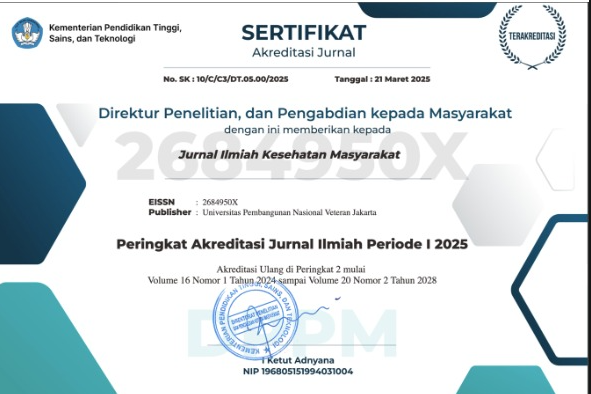Hubungan Tingkat Stres dan Body Image terhadap Risiko Eating Disorder pada Remaja SMK Kesehatan Fahd Islamic School pada Masa Pandemi
Abstract
Abstrak
Latar Belakang: Gangguan makan yang terjadi pada remaja saat masa pandemi terdapat peningkatan sekitar 20%. Remaja yang mengalami gangguan makan pada masa pandemi dapat dipengaruhi dari tingkat stres sehingga merasakan keinginan makan secara berlebihan serta dapat berpengaruh terhadap body image. Tujuan penelitian untuk menganalisis hubungan antara tingkat stres dan citra tubuh terhadap gangguan makan pada remaja SMK Kesehatan Fahd Islamic School di masa pandemi COVID-19.
Metode: Penelitian ini menggunakan metode kuantitatif dengan desain cross-sectional. Sampel yang digunakan sebanyak 260 responden usia 15-17 tahun di SMK Kesehatan Fahd Islamic School. Pengambilan data menggunakan teknik consecutive sampling. Data dikumpulkan menggunakan kuesioner PSS-10 (Perceived Stress Scale-10), BSQ-34 (Body Shape Questionnare-34), dan EAT-26 (Eating Attitudes Test-26). Analisis data berupa uji regresi logistik berganda.
Hasil: Berdasarkan hasil analisis regresi logistik berganda, diperoleh p-value = 0,0001 dengan nilai OR = 4,736 untuk hubungan tingkat stres dengan risiko eating disorder dan diperoleh p-value = 0,017 dengan nilai OR = 2,182 untuk hubungan body image dengan risiko eating disorder.
Kesimpulan: Terdapat hubungan yang signifikan antara tingkat stres dan body image dengan risiko eating disorder pada remaja SMK Kesehatan Fahd Islamic School pada masa pandemi.
Relationship of Stress Level and Body Image to the Risk of Eating Disorder in Adolescents at SMK Kesehatan Fahd Islamic School During Pandemic
Abstract
Background: Eating disorders in adolescents increased by around 20% during the pandemic. Stress levels can influence adolescents who experience eating disorders during a pandemic, so their desire to overeat can affect body image. This study aims to analyze the relationship between stress level and body image to the risk of eating disorders of students during the pandemic at SMK Kesehatan Fahd Islamic School.
Methods: This study used a quantitative method with a cross-sectional design. The sample used was 260 respondents aged 15-17 years at the SMK Kesehatan Fahd Islamic School. Retrieval of this data using a consecutive sampling technique. Data was collected using the PSS-10 (Perceived Stress Scale-10), BSQ-34 (Body Shape Questionnaire-34), and EAT-26 (Eating Attitudes Test-26) questionnaires. In this study, data analysis was carried out as a multiple logistic regression.
Results: The results of the multiple logistic regression, obtained p-value = 0.0001 with OR = 4,736 for the relationship between stress levels and risk of eating disorders and obtained p-value = 0.017 with OR = 2.182 for the relationship between body image and risk of eating disorders.
Conclusion: The conclusion of this study is that there is a significant relationship between the level of stress and body image with the risk of eating disorders with among adolescents at SMK Kesehatan Fahd Islamic School during pandemic.
References
Perhimpunan Dokter Paru Indonesia. Pneumonia Covid-19 Diagnosis & Penatalaksanaan di Indonesia. In: Ebook Pneumonia COVID-19. Jakarta: Perhimpunan Dokter Paru Indonesia; 2020. Hal. 1–67.
Kementerian Kesehatan Republik Indonesia. Situasi Terkini Perkembangan Coronavirus Disease (COVID-19). Jakarta.2022. Hal 1–4
Modjo R, Lestari F, Haryanto RB, Ronoatmodjo S, Purwana R, Trihandini I, et al. Pengalaman Indonesia dalam Menangani Wabah COVID-19 di 17 Provinsi Periode Januari - Juli 2020. Edisi 1. Jakarta: Badan Nasional Penanggulangan Bencana dan Universitas Indonesia.2020. 1–574 p.
Rahmayanti D, Marisa FM, Lenny K. Adolescents Mental Health During Covid-19 Pandemic. Jurnal Ilmu Psikologi. 2023.23(1):91–101.
Yu Z, Muehleman V. Eating Disorders and Metabolic Diseases. International Journal Environmental Research and Public Health. 2023;20(3):1–9.
Badrah S, Noviasty R, Susanti R. Screening of Eating Disorders Risk with Scoff Tool on Adolescents in Samarinda City. Journal La Medihealtico. 2020.1(2):26–31.
Wahidah. Hubungan antara Masa Pubertas dengan Perilaku Diet pada Remaja Putri di SMAN 2 Woha. Jurnal Studi Keislaman dan Ilmu Pendidikan. 2018.6(1):81–9.
Supariasa IDN, Hardinsyah. Ilmu Gizi : Teori & Aplikasi. Jakarta: Penerbit Buku Kedokteran EGC. 2017. Hal 1–621.
Denich AU, Ifdil. Konsep Body Image Remaja Putri. Jurnal Konseling dan Pendidikan. 2015.3(2):55–61.
Irawan SD, Safitri. Hubungan antara Body Image dan Perilaku Diet Mahasiswi Universitas Esa Unggul. Jurnal Psikologi. 2014.12(1):18–25.
Wardani MS. Hubungan Body Image dan Pola Makan dengan Status Gizi pada Mahasiswi Islamic Boarding School. Universitas Darussalam Gontor. 2018.
Oktapianingsi, Sartika AN. Hubungan antara Citra Tubuh dengan Kejadian Gangguan Makan pada Remaja Putri. Jurnal Mutiara Kesehatan Masyarakat. 2022.7(2):101–7.
Noe F, Farida HDK, Rahayu W. Hubungan Tingkat Stres dengan Eating Disorder pada Mahasiswa yang Tinggal di Asrama Putri Universitas Tibhuwana Tunggadewi (Unitri). Jurnal Nursing News. 2019.4(1):159–70.
Ghafouri KJ, Qadhi AH, Ghaith MM, Azhar WF, Azzeh FS, Habibullah MM. Eating Disorders amongst Adolescents in Makkah: Effects of Stress and Smoking. Medical Science. 2021.25(110):767–75.
Habibah NU, Tsani AFA, DW S. The Effect of Korean Wave on Body Image and Eating Disorders Among Female Adolescents in Yogyakarta, Indonesia. Jurnal Gizi Klinik Indonesia. 2021.18(2):78–85.
Pratiwi MSA, Yani MVW, Agustini MPA, Yuliyatni PCD. Hubungan Persepsi Tubuh dengan Kejadian Eating Disorder Remaja Putri di Denpasar. Jurnal Medika Udayana. 2021.10(9):67–73.
Tumenggung I, Sofyawati DT. Eating Disorders pada Siswa SMA di Kota Gorontalo. Health Nutritions Journal. 2018.4(1):26–35.









.jpg)








